Business Strategy Report: Macro and Micro Analysis of Uber
VerifiedAdded on 2022/12/27
|14
|4476
|65
Report
AI Summary
This report provides a comprehensive analysis of Uber's business strategy, examining both its macro and micro environments. It begins with an introduction to business strategy and an overview of Uber's mission, vision, and strategic goals. The report then delves into the impact of the macro environment on Uber, using PESTLE analysis to assess political, economic, social, technological, legal, and environmental factors. Internal organizational capabilities are evaluated using the McKinsey 7S model and the VRIO framework. The report applies Porter's Five Forces model and the Ansoff matrix to analyze Uber's competitive landscape and growth strategies. Furthermore, it explores various strategic planning theories and models relevant to Uber's operations, including stakeholder analysis and benchmarking indicators. The analysis includes an overview of Uber's value chain and its primary and secondary activities. The report concludes with a summary of the key findings and insights into Uber's strategic approach. All the models are applied to Uber's business to evaluate its strategies and competitive edge in the market.
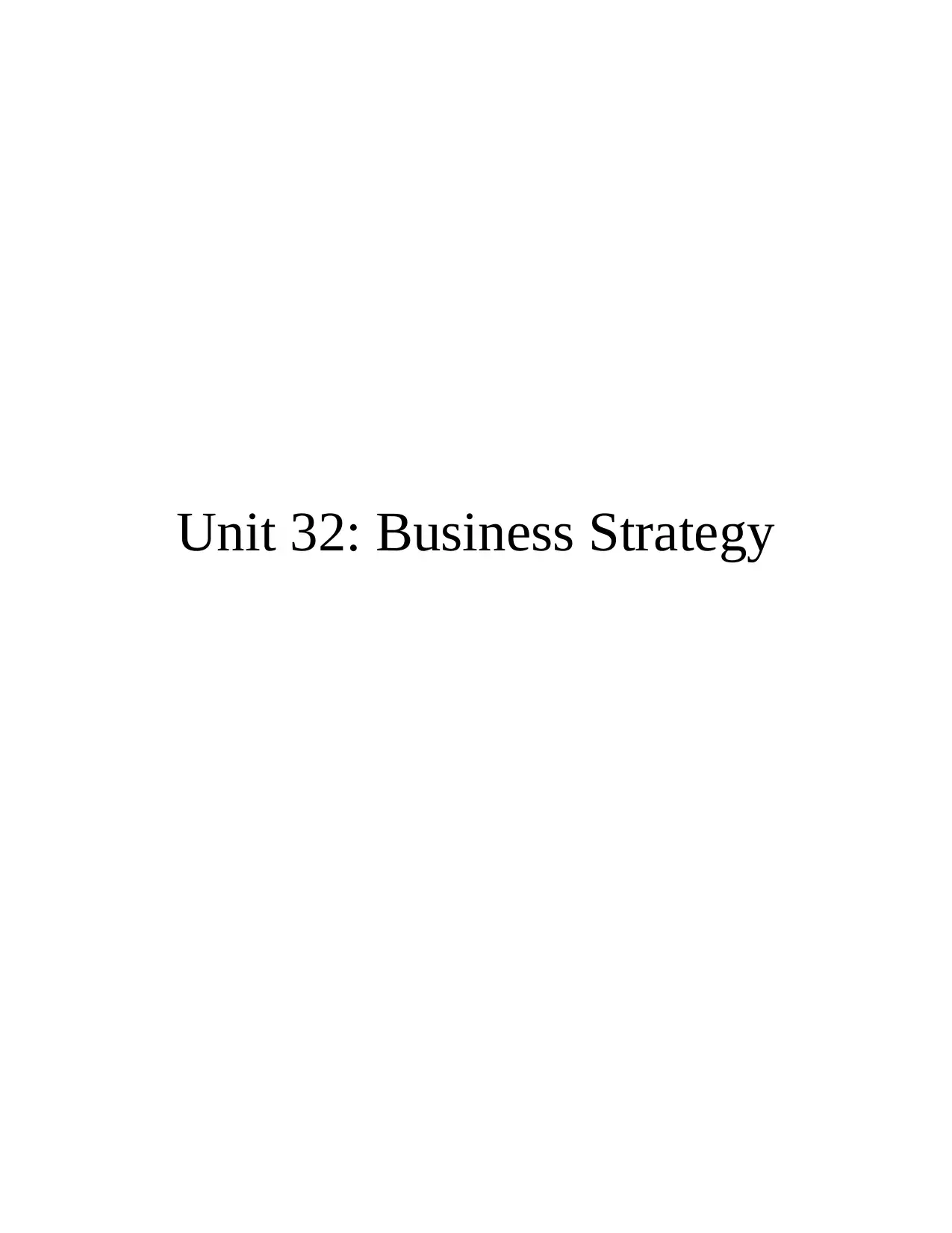
Unit 32: Business Strategy
Paraphrase This Document
Need a fresh take? Get an instant paraphrase of this document with our AI Paraphraser
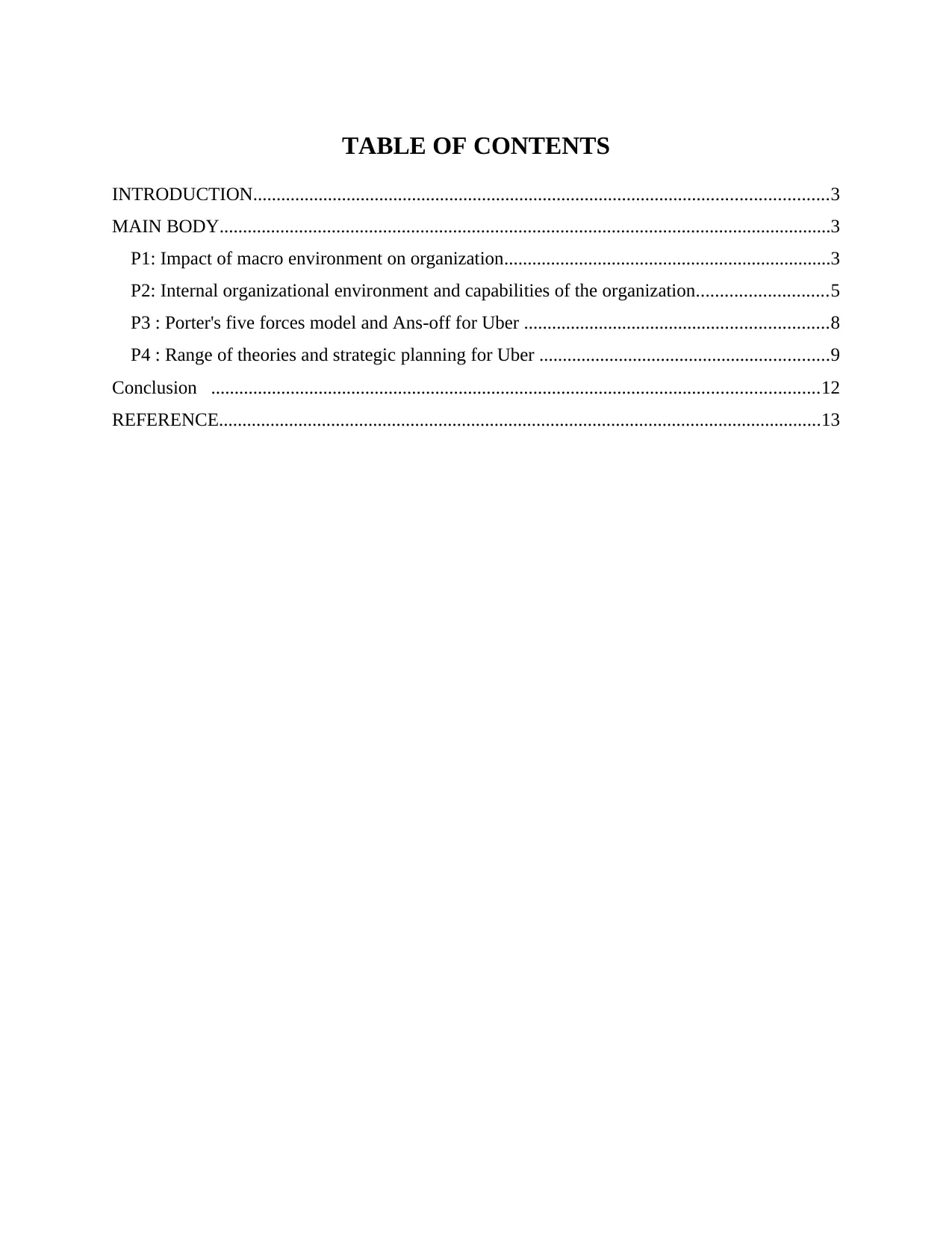
TABLE OF CONTENTS
INTRODUCTION...........................................................................................................................3
MAIN BODY...................................................................................................................................3
P1: Impact of macro environment on organization......................................................................3
P2: Internal organizational environment and capabilities of the organization............................5
P3 : Porter's five forces model and Ans-off for Uber .................................................................8
P4 : Range of theories and strategic planning for Uber ..............................................................9
Conclusion ..................................................................................................................................12
REFERENCE.................................................................................................................................13
INTRODUCTION...........................................................................................................................3
MAIN BODY...................................................................................................................................3
P1: Impact of macro environment on organization......................................................................3
P2: Internal organizational environment and capabilities of the organization............................5
P3 : Porter's five forces model and Ans-off for Uber .................................................................8
P4 : Range of theories and strategic planning for Uber ..............................................................9
Conclusion ..................................................................................................................................12
REFERENCE.................................................................................................................................13
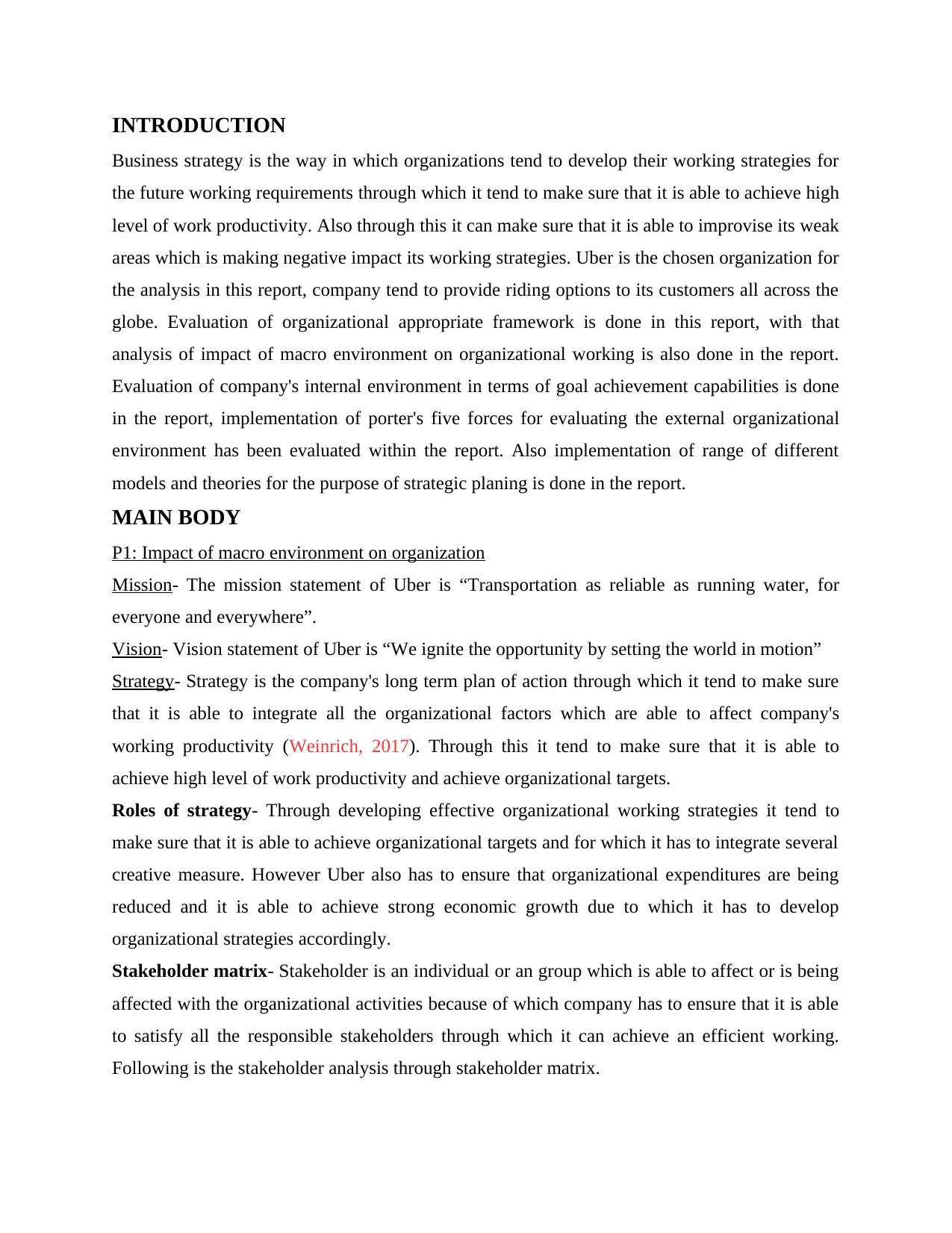
INTRODUCTION
Business strategy is the way in which organizations tend to develop their working strategies for
the future working requirements through which it tend to make sure that it is able to achieve high
level of work productivity. Also through this it can make sure that it is able to improvise its weak
areas which is making negative impact its working strategies. Uber is the chosen organization for
the analysis in this report, company tend to provide riding options to its customers all across the
globe. Evaluation of organizational appropriate framework is done in this report, with that
analysis of impact of macro environment on organizational working is also done in the report.
Evaluation of company's internal environment in terms of goal achievement capabilities is done
in the report, implementation of porter's five forces for evaluating the external organizational
environment has been evaluated within the report. Also implementation of range of different
models and theories for the purpose of strategic planing is done in the report.
MAIN BODY
P1: Impact of macro environment on organization
Mission- The mission statement of Uber is “Transportation as reliable as running water, for
everyone and everywhere”.
Vision- Vision statement of Uber is “We ignite the opportunity by setting the world in motion”
Strategy- Strategy is the company's long term plan of action through which it tend to make sure
that it is able to integrate all the organizational factors which are able to affect company's
working productivity (Weinrich, 2017). Through this it tend to make sure that it is able to
achieve high level of work productivity and achieve organizational targets.
Roles of strategy- Through developing effective organizational working strategies it tend to
make sure that it is able to achieve organizational targets and for which it has to integrate several
creative measure. However Uber also has to ensure that organizational expenditures are being
reduced and it is able to achieve strong economic growth due to which it has to develop
organizational strategies accordingly.
Stakeholder matrix- Stakeholder is an individual or an group which is able to affect or is being
affected with the organizational activities because of which company has to ensure that it is able
to satisfy all the responsible stakeholders through which it can achieve an efficient working.
Following is the stakeholder analysis through stakeholder matrix.
Business strategy is the way in which organizations tend to develop their working strategies for
the future working requirements through which it tend to make sure that it is able to achieve high
level of work productivity. Also through this it can make sure that it is able to improvise its weak
areas which is making negative impact its working strategies. Uber is the chosen organization for
the analysis in this report, company tend to provide riding options to its customers all across the
globe. Evaluation of organizational appropriate framework is done in this report, with that
analysis of impact of macro environment on organizational working is also done in the report.
Evaluation of company's internal environment in terms of goal achievement capabilities is done
in the report, implementation of porter's five forces for evaluating the external organizational
environment has been evaluated within the report. Also implementation of range of different
models and theories for the purpose of strategic planing is done in the report.
MAIN BODY
P1: Impact of macro environment on organization
Mission- The mission statement of Uber is “Transportation as reliable as running water, for
everyone and everywhere”.
Vision- Vision statement of Uber is “We ignite the opportunity by setting the world in motion”
Strategy- Strategy is the company's long term plan of action through which it tend to make sure
that it is able to integrate all the organizational factors which are able to affect company's
working productivity (Weinrich, 2017). Through this it tend to make sure that it is able to
achieve high level of work productivity and achieve organizational targets.
Roles of strategy- Through developing effective organizational working strategies it tend to
make sure that it is able to achieve organizational targets and for which it has to integrate several
creative measure. However Uber also has to ensure that organizational expenditures are being
reduced and it is able to achieve strong economic growth due to which it has to develop
organizational strategies accordingly.
Stakeholder matrix- Stakeholder is an individual or an group which is able to affect or is being
affected with the organizational activities because of which company has to ensure that it is able
to satisfy all the responsible stakeholders through which it can achieve an efficient working.
Following is the stakeholder analysis through stakeholder matrix.
⊘ This is a preview!⊘
Do you want full access?
Subscribe today to unlock all pages.

Trusted by 1+ million students worldwide
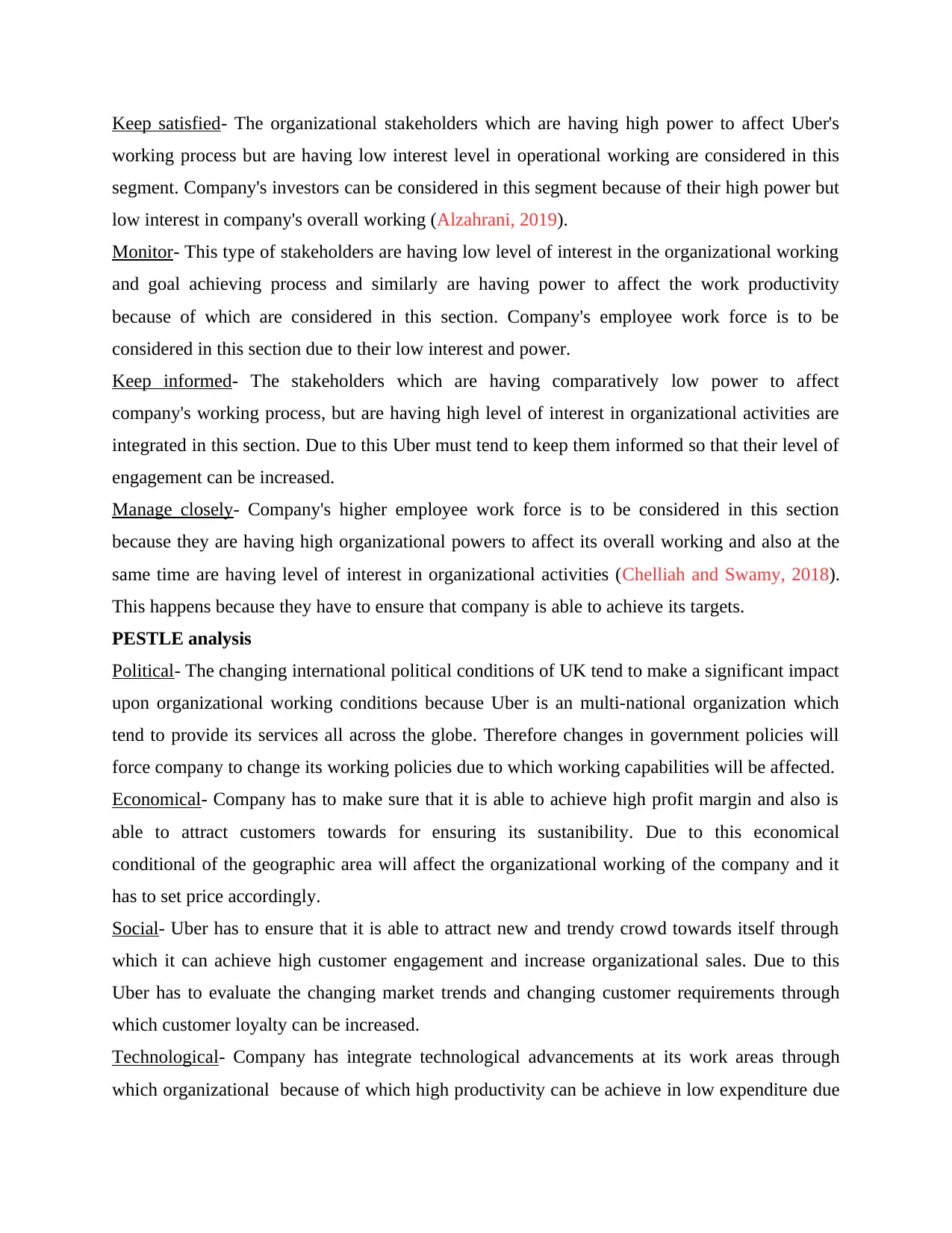
Keep satisfied- The organizational stakeholders which are having high power to affect Uber's
working process but are having low interest level in operational working are considered in this
segment. Company's investors can be considered in this segment because of their high power but
low interest in company's overall working (Alzahrani, 2019).
Monitor- This type of stakeholders are having low level of interest in the organizational working
and goal achieving process and similarly are having power to affect the work productivity
because of which are considered in this section. Company's employee work force is to be
considered in this section due to their low interest and power.
Keep informed- The stakeholders which are having comparatively low power to affect
company's working process, but are having high level of interest in organizational activities are
integrated in this section. Due to this Uber must tend to keep them informed so that their level of
engagement can be increased.
Manage closely- Company's higher employee work force is to be considered in this section
because they are having high organizational powers to affect its overall working and also at the
same time are having level of interest in organizational activities (Chelliah and Swamy, 2018).
This happens because they have to ensure that company is able to achieve its targets.
PESTLE analysis
Political- The changing international political conditions of UK tend to make a significant impact
upon organizational working conditions because Uber is an multi-national organization which
tend to provide its services all across the globe. Therefore changes in government policies will
force company to change its working policies due to which working capabilities will be affected.
Economical- Company has to make sure that it is able to achieve high profit margin and also is
able to attract customers towards for ensuring its sustanibility. Due to this economical
conditional of the geographic area will affect the organizational working of the company and it
has to set price accordingly.
Social- Uber has to ensure that it is able to attract new and trendy crowd towards itself through
which it can achieve high customer engagement and increase organizational sales. Due to this
Uber has to evaluate the changing market trends and changing customer requirements through
which customer loyalty can be increased.
Technological- Company has integrate technological advancements at its work areas through
which organizational because of which high productivity can be achieve in low expenditure due
working process but are having low interest level in operational working are considered in this
segment. Company's investors can be considered in this segment because of their high power but
low interest in company's overall working (Alzahrani, 2019).
Monitor- This type of stakeholders are having low level of interest in the organizational working
and goal achieving process and similarly are having power to affect the work productivity
because of which are considered in this section. Company's employee work force is to be
considered in this section due to their low interest and power.
Keep informed- The stakeholders which are having comparatively low power to affect
company's working process, but are having high level of interest in organizational activities are
integrated in this section. Due to this Uber must tend to keep them informed so that their level of
engagement can be increased.
Manage closely- Company's higher employee work force is to be considered in this section
because they are having high organizational powers to affect its overall working and also at the
same time are having level of interest in organizational activities (Chelliah and Swamy, 2018).
This happens because they have to ensure that company is able to achieve its targets.
PESTLE analysis
Political- The changing international political conditions of UK tend to make a significant impact
upon organizational working conditions because Uber is an multi-national organization which
tend to provide its services all across the globe. Therefore changes in government policies will
force company to change its working policies due to which working capabilities will be affected.
Economical- Company has to make sure that it is able to achieve high profit margin and also is
able to attract customers towards for ensuring its sustanibility. Due to this economical
conditional of the geographic area will affect the organizational working of the company and it
has to set price accordingly.
Social- Uber has to ensure that it is able to attract new and trendy crowd towards itself through
which it can achieve high customer engagement and increase organizational sales. Due to this
Uber has to evaluate the changing market trends and changing customer requirements through
which customer loyalty can be increased.
Technological- Company has integrate technological advancements at its work areas through
which organizational because of which high productivity can be achieve in low expenditure due
Paraphrase This Document
Need a fresh take? Get an instant paraphrase of this document with our AI Paraphraser
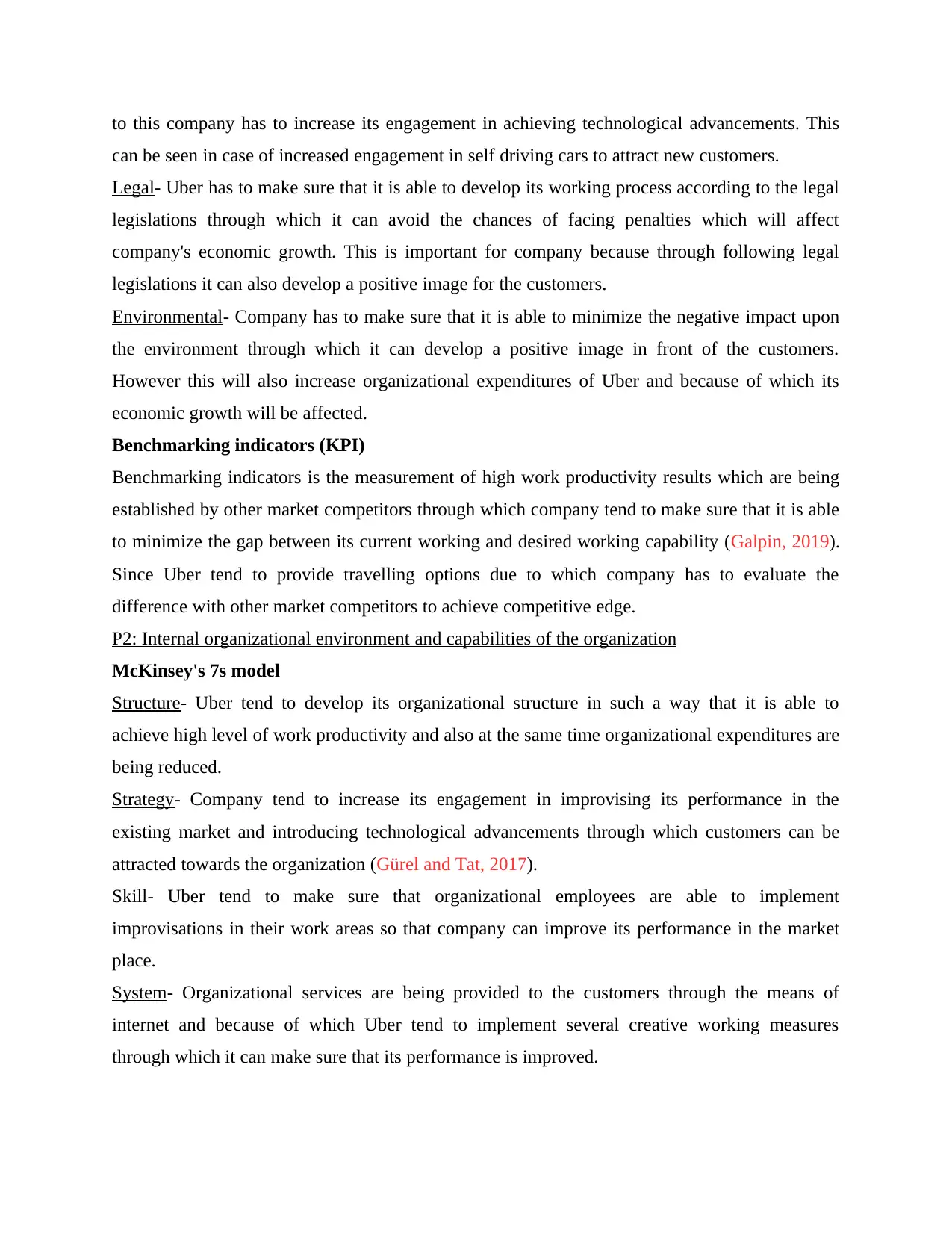
to this company has to increase its engagement in achieving technological advancements. This
can be seen in case of increased engagement in self driving cars to attract new customers.
Legal- Uber has to make sure that it is able to develop its working process according to the legal
legislations through which it can avoid the chances of facing penalties which will affect
company's economic growth. This is important for company because through following legal
legislations it can also develop a positive image for the customers.
Environmental- Company has to make sure that it is able to minimize the negative impact upon
the environment through which it can develop a positive image in front of the customers.
However this will also increase organizational expenditures of Uber and because of which its
economic growth will be affected.
Benchmarking indicators (KPI)
Benchmarking indicators is the measurement of high work productivity results which are being
established by other market competitors through which company tend to make sure that it is able
to minimize the gap between its current working and desired working capability (Galpin, 2019).
Since Uber tend to provide travelling options due to which company has to evaluate the
difference with other market competitors to achieve competitive edge.
P2: Internal organizational environment and capabilities of the organization
McKinsey's 7s model
Structure- Uber tend to develop its organizational structure in such a way that it is able to
achieve high level of work productivity and also at the same time organizational expenditures are
being reduced.
Strategy- Company tend to increase its engagement in improvising its performance in the
existing market and introducing technological advancements through which customers can be
attracted towards the organization (Gürel and Tat, 2017).
Skill- Uber tend to make sure that organizational employees are able to implement
improvisations in their work areas so that company can improve its performance in the market
place.
System- Organizational services are being provided to the customers through the means of
internet and because of which Uber tend to implement several creative working measures
through which it can make sure that its performance is improved.
can be seen in case of increased engagement in self driving cars to attract new customers.
Legal- Uber has to make sure that it is able to develop its working process according to the legal
legislations through which it can avoid the chances of facing penalties which will affect
company's economic growth. This is important for company because through following legal
legislations it can also develop a positive image for the customers.
Environmental- Company has to make sure that it is able to minimize the negative impact upon
the environment through which it can develop a positive image in front of the customers.
However this will also increase organizational expenditures of Uber and because of which its
economic growth will be affected.
Benchmarking indicators (KPI)
Benchmarking indicators is the measurement of high work productivity results which are being
established by other market competitors through which company tend to make sure that it is able
to minimize the gap between its current working and desired working capability (Galpin, 2019).
Since Uber tend to provide travelling options due to which company has to evaluate the
difference with other market competitors to achieve competitive edge.
P2: Internal organizational environment and capabilities of the organization
McKinsey's 7s model
Structure- Uber tend to develop its organizational structure in such a way that it is able to
achieve high level of work productivity and also at the same time organizational expenditures are
being reduced.
Strategy- Company tend to increase its engagement in improvising its performance in the
existing market and introducing technological advancements through which customers can be
attracted towards the organization (Gürel and Tat, 2017).
Skill- Uber tend to make sure that organizational employees are able to implement
improvisations in their work areas so that company can improve its performance in the market
place.
System- Organizational services are being provided to the customers through the means of
internet and because of which Uber tend to implement several creative working measures
through which it can make sure that its performance is improved.
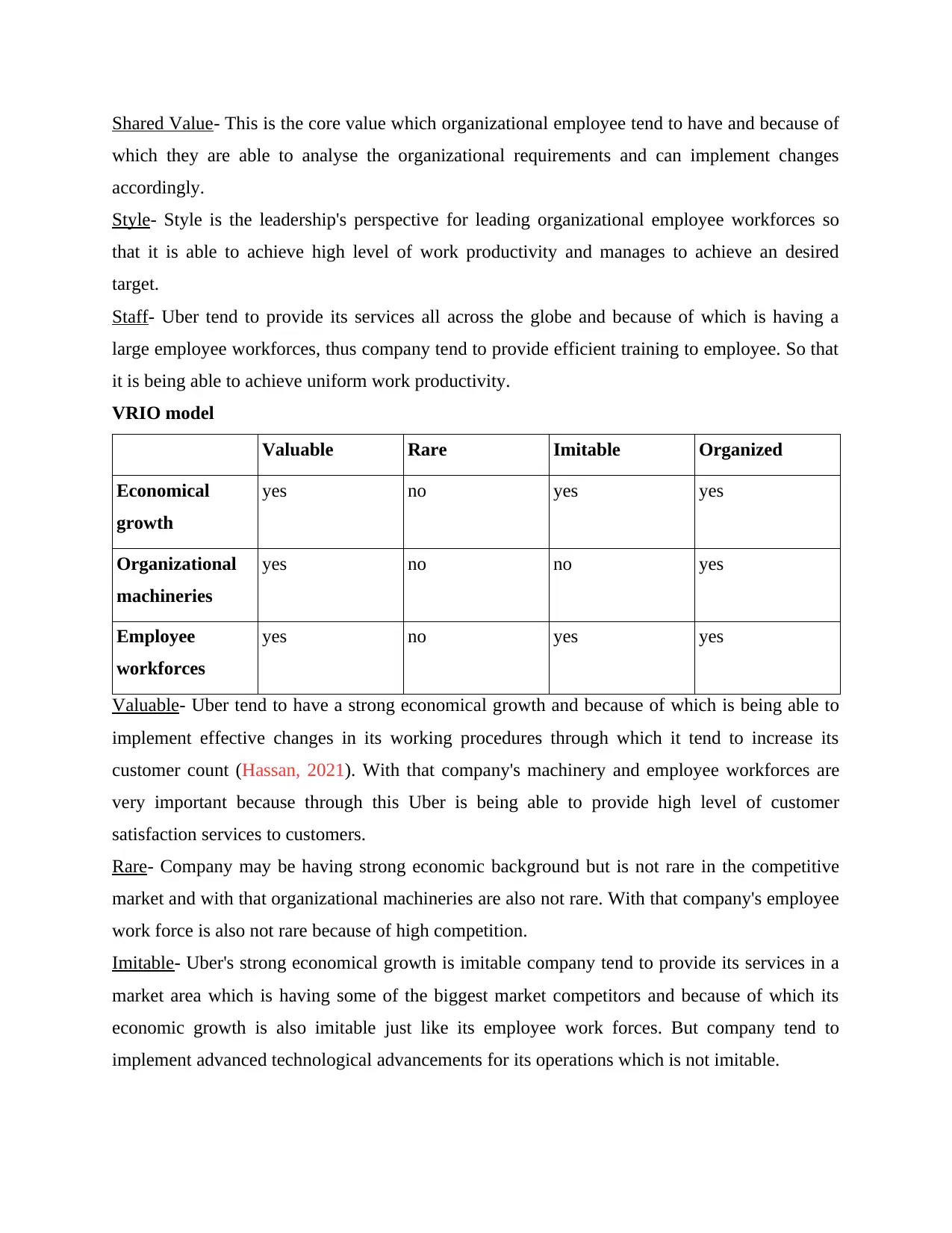
Shared Value- This is the core value which organizational employee tend to have and because of
which they are able to analyse the organizational requirements and can implement changes
accordingly.
Style- Style is the leadership's perspective for leading organizational employee workforces so
that it is able to achieve high level of work productivity and manages to achieve an desired
target.
Staff- Uber tend to provide its services all across the globe and because of which is having a
large employee workforces, thus company tend to provide efficient training to employee. So that
it is being able to achieve uniform work productivity.
VRIO model
Valuable Rare Imitable Organized
Economical
growth
yes no yes yes
Organizational
machineries
yes no no yes
Employee
workforces
yes no yes yes
Valuable- Uber tend to have a strong economical growth and because of which is being able to
implement effective changes in its working procedures through which it tend to increase its
customer count (Hassan, 2021). With that company's machinery and employee workforces are
very important because through this Uber is being able to provide high level of customer
satisfaction services to customers.
Rare- Company may be having strong economic background but is not rare in the competitive
market and with that organizational machineries are also not rare. With that company's employee
work force is also not rare because of high competition.
Imitable- Uber's strong economical growth is imitable company tend to provide its services in a
market area which is having some of the biggest market competitors and because of which its
economic growth is also imitable just like its employee work forces. But company tend to
implement advanced technological advancements for its operations which is not imitable.
which they are able to analyse the organizational requirements and can implement changes
accordingly.
Style- Style is the leadership's perspective for leading organizational employee workforces so
that it is able to achieve high level of work productivity and manages to achieve an desired
target.
Staff- Uber tend to provide its services all across the globe and because of which is having a
large employee workforces, thus company tend to provide efficient training to employee. So that
it is being able to achieve uniform work productivity.
VRIO model
Valuable Rare Imitable Organized
Economical
growth
yes no yes yes
Organizational
machineries
yes no no yes
Employee
workforces
yes no yes yes
Valuable- Uber tend to have a strong economical growth and because of which is being able to
implement effective changes in its working procedures through which it tend to increase its
customer count (Hassan, 2021). With that company's machinery and employee workforces are
very important because through this Uber is being able to provide high level of customer
satisfaction services to customers.
Rare- Company may be having strong economic background but is not rare in the competitive
market and with that organizational machineries are also not rare. With that company's employee
work force is also not rare because of high competition.
Imitable- Uber's strong economical growth is imitable company tend to provide its services in a
market area which is having some of the biggest market competitors and because of which its
economic growth is also imitable just like its employee work forces. But company tend to
implement advanced technological advancements for its operations which is not imitable.
⊘ This is a preview!⊘
Do you want full access?
Subscribe today to unlock all pages.

Trusted by 1+ million students worldwide
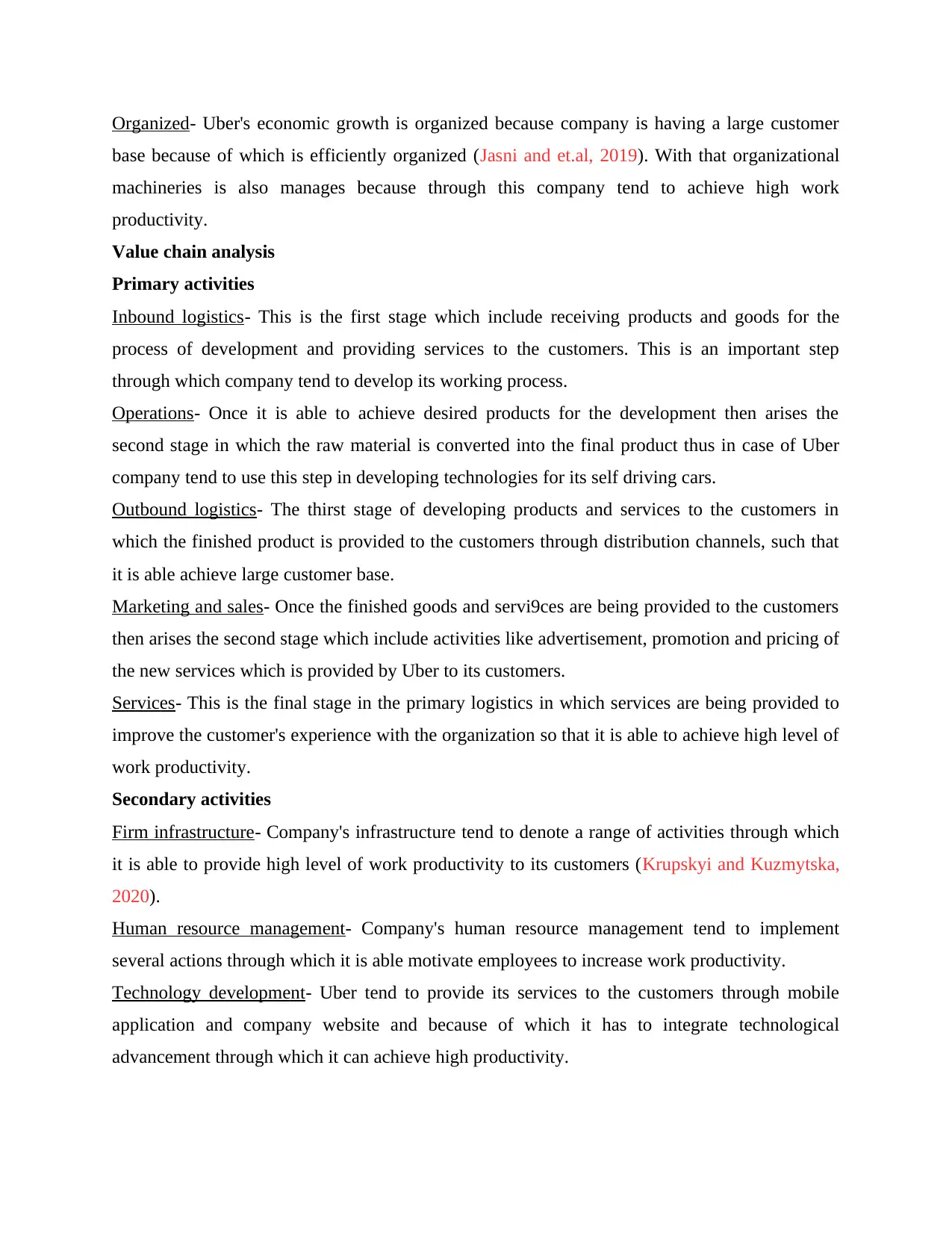
Organized- Uber's economic growth is organized because company is having a large customer
base because of which is efficiently organized (Jasni and et.al, 2019). With that organizational
machineries is also manages because through this company tend to achieve high work
productivity.
Value chain analysis
Primary activities
Inbound logistics- This is the first stage which include receiving products and goods for the
process of development and providing services to the customers. This is an important step
through which company tend to develop its working process.
Operations- Once it is able to achieve desired products for the development then arises the
second stage in which the raw material is converted into the final product thus in case of Uber
company tend to use this step in developing technologies for its self driving cars.
Outbound logistics- The thirst stage of developing products and services to the customers in
which the finished product is provided to the customers through distribution channels, such that
it is able achieve large customer base.
Marketing and sales- Once the finished goods and servi9ces are being provided to the customers
then arises the second stage which include activities like advertisement, promotion and pricing of
the new services which is provided by Uber to its customers.
Services- This is the final stage in the primary logistics in which services are being provided to
improve the customer's experience with the organization so that it is able to achieve high level of
work productivity.
Secondary activities
Firm infrastructure- Company's infrastructure tend to denote a range of activities through which
it is able to provide high level of work productivity to its customers (Krupskyi and Kuzmytska,
2020).
Human resource management- Company's human resource management tend to implement
several actions through which it is able motivate employees to increase work productivity.
Technology development- Uber tend to provide its services to the customers through mobile
application and company website and because of which it has to integrate technological
advancement through which it can achieve high productivity.
base because of which is efficiently organized (Jasni and et.al, 2019). With that organizational
machineries is also manages because through this company tend to achieve high work
productivity.
Value chain analysis
Primary activities
Inbound logistics- This is the first stage which include receiving products and goods for the
process of development and providing services to the customers. This is an important step
through which company tend to develop its working process.
Operations- Once it is able to achieve desired products for the development then arises the
second stage in which the raw material is converted into the final product thus in case of Uber
company tend to use this step in developing technologies for its self driving cars.
Outbound logistics- The thirst stage of developing products and services to the customers in
which the finished product is provided to the customers through distribution channels, such that
it is able achieve large customer base.
Marketing and sales- Once the finished goods and servi9ces are being provided to the customers
then arises the second stage which include activities like advertisement, promotion and pricing of
the new services which is provided by Uber to its customers.
Services- This is the final stage in the primary logistics in which services are being provided to
improve the customer's experience with the organization so that it is able to achieve high level of
work productivity.
Secondary activities
Firm infrastructure- Company's infrastructure tend to denote a range of activities through which
it is able to provide high level of work productivity to its customers (Krupskyi and Kuzmytska,
2020).
Human resource management- Company's human resource management tend to implement
several actions through which it is able motivate employees to increase work productivity.
Technology development- Uber tend to provide its services to the customers through mobile
application and company website and because of which it has to integrate technological
advancement through which it can achieve high productivity.
Paraphrase This Document
Need a fresh take? Get an instant paraphrase of this document with our AI Paraphraser
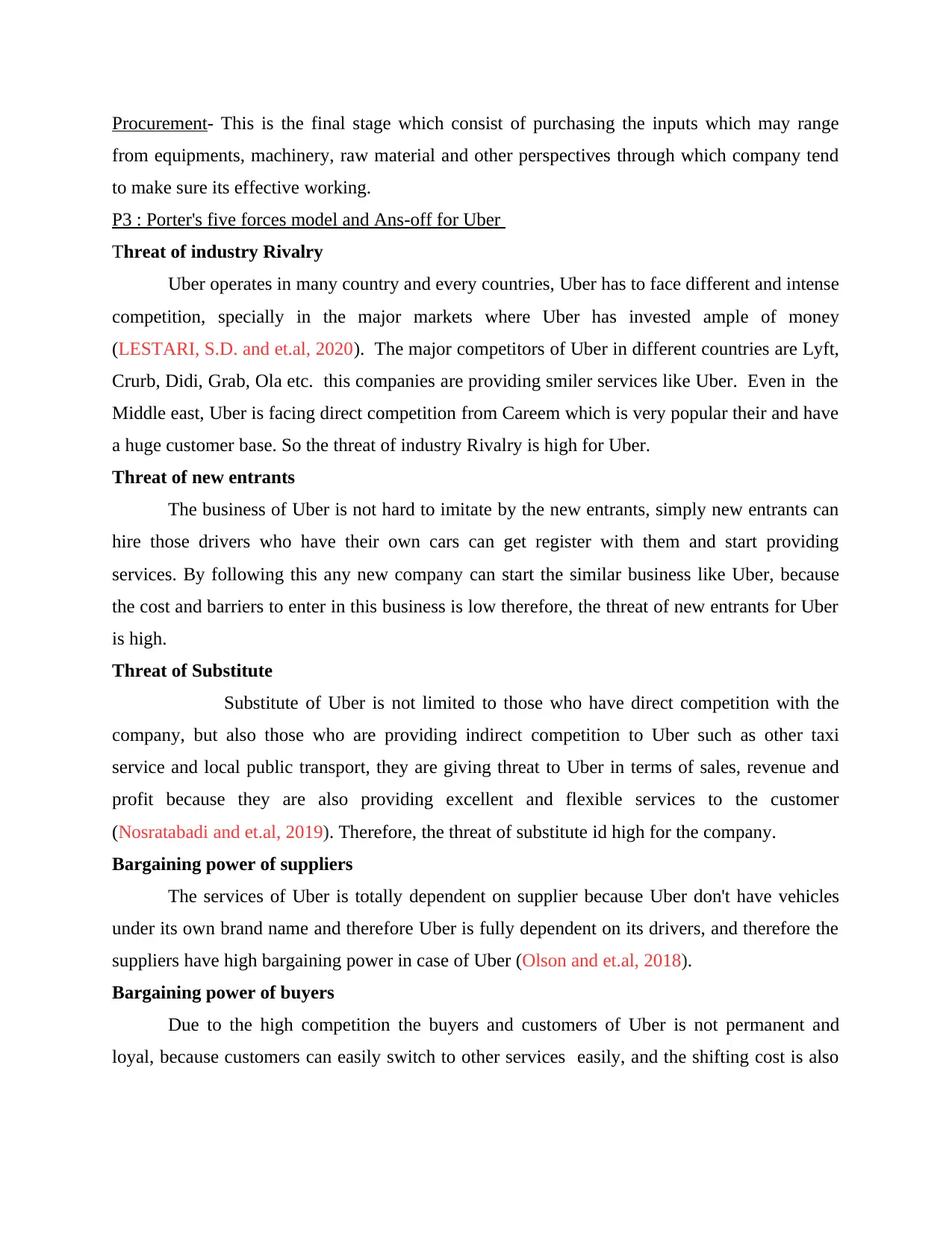
Procurement- This is the final stage which consist of purchasing the inputs which may range
from equipments, machinery, raw material and other perspectives through which company tend
to make sure its effective working.
P3 : Porter's five forces model and Ans-off for Uber
Threat of industry Rivalry
Uber operates in many country and every countries, Uber has to face different and intense
competition, specially in the major markets where Uber has invested ample of money
(LESTARI, S.D. and et.al, 2020). The major competitors of Uber in different countries are Lyft,
Crurb, Didi, Grab, Ola etc. this companies are providing smiler services like Uber. Even in the
Middle east, Uber is facing direct competition from Careem which is very popular their and have
a huge customer base. So the threat of industry Rivalry is high for Uber.
Threat of new entrants
The business of Uber is not hard to imitate by the new entrants, simply new entrants can
hire those drivers who have their own cars can get register with them and start providing
services. By following this any new company can start the similar business like Uber, because
the cost and barriers to enter in this business is low therefore, the threat of new entrants for Uber
is high.
Threat of Substitute
Substitute of Uber is not limited to those who have direct competition with the
company, but also those who are providing indirect competition to Uber such as other taxi
service and local public transport, they are giving threat to Uber in terms of sales, revenue and
profit because they are also providing excellent and flexible services to the customer
(Nosratabadi and et.al, 2019). Therefore, the threat of substitute id high for the company.
Bargaining power of suppliers
The services of Uber is totally dependent on supplier because Uber don't have vehicles
under its own brand name and therefore Uber is fully dependent on its drivers, and therefore the
suppliers have high bargaining power in case of Uber (Olson and et.al, 2018).
Bargaining power of buyers
Due to the high competition the buyers and customers of Uber is not permanent and
loyal, because customers can easily switch to other services easily, and the shifting cost is also
from equipments, machinery, raw material and other perspectives through which company tend
to make sure its effective working.
P3 : Porter's five forces model and Ans-off for Uber
Threat of industry Rivalry
Uber operates in many country and every countries, Uber has to face different and intense
competition, specially in the major markets where Uber has invested ample of money
(LESTARI, S.D. and et.al, 2020). The major competitors of Uber in different countries are Lyft,
Crurb, Didi, Grab, Ola etc. this companies are providing smiler services like Uber. Even in the
Middle east, Uber is facing direct competition from Careem which is very popular their and have
a huge customer base. So the threat of industry Rivalry is high for Uber.
Threat of new entrants
The business of Uber is not hard to imitate by the new entrants, simply new entrants can
hire those drivers who have their own cars can get register with them and start providing
services. By following this any new company can start the similar business like Uber, because
the cost and barriers to enter in this business is low therefore, the threat of new entrants for Uber
is high.
Threat of Substitute
Substitute of Uber is not limited to those who have direct competition with the
company, but also those who are providing indirect competition to Uber such as other taxi
service and local public transport, they are giving threat to Uber in terms of sales, revenue and
profit because they are also providing excellent and flexible services to the customer
(Nosratabadi and et.al, 2019). Therefore, the threat of substitute id high for the company.
Bargaining power of suppliers
The services of Uber is totally dependent on supplier because Uber don't have vehicles
under its own brand name and therefore Uber is fully dependent on its drivers, and therefore the
suppliers have high bargaining power in case of Uber (Olson and et.al, 2018).
Bargaining power of buyers
Due to the high competition the buyers and customers of Uber is not permanent and
loyal, because customers can easily switch to other services easily, and the shifting cost is also
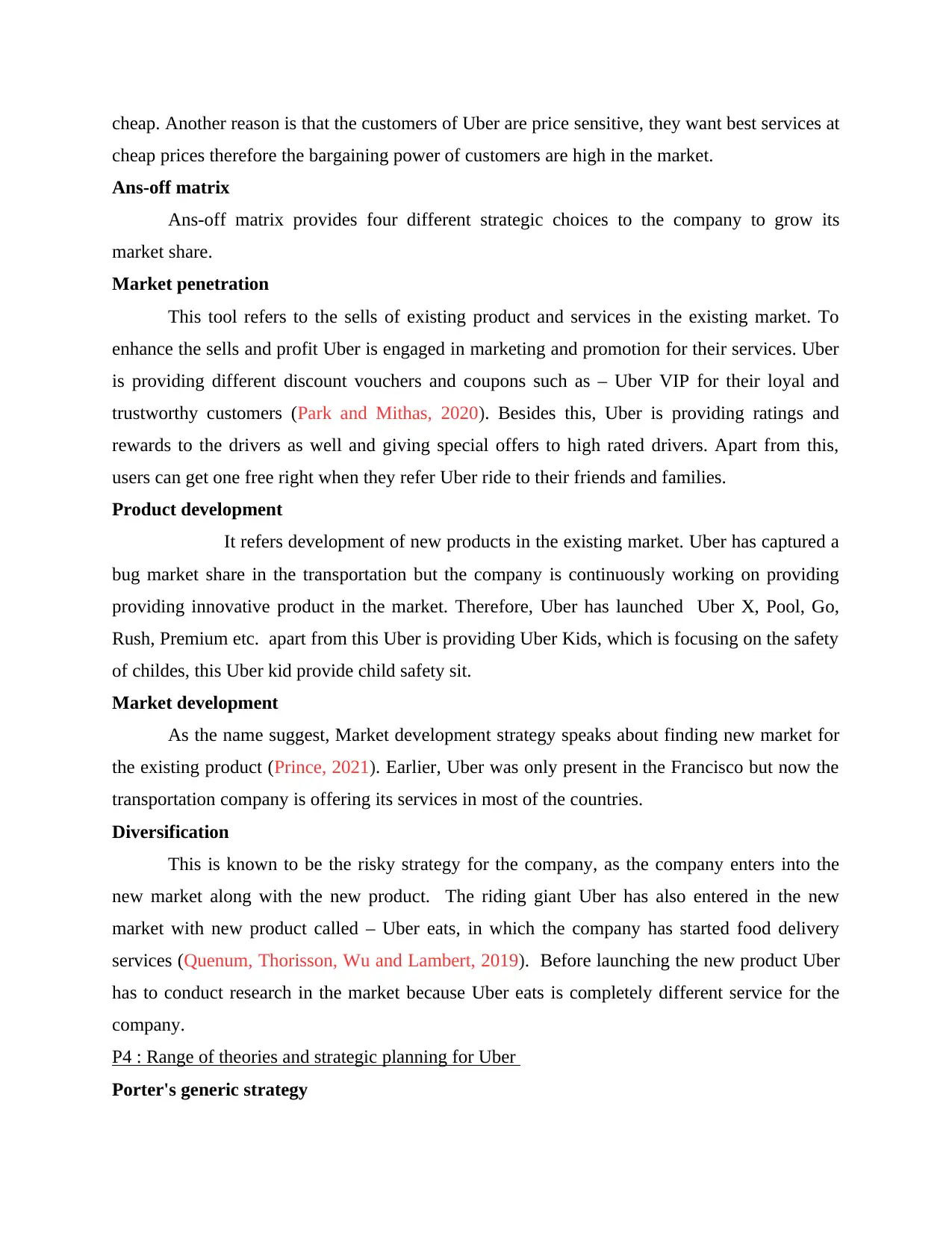
cheap. Another reason is that the customers of Uber are price sensitive, they want best services at
cheap prices therefore the bargaining power of customers are high in the market.
Ans-off matrix
Ans-off matrix provides four different strategic choices to the company to grow its
market share.
Market penetration
This tool refers to the sells of existing product and services in the existing market. To
enhance the sells and profit Uber is engaged in marketing and promotion for their services. Uber
is providing different discount vouchers and coupons such as – Uber VIP for their loyal and
trustworthy customers (Park and Mithas, 2020). Besides this, Uber is providing ratings and
rewards to the drivers as well and giving special offers to high rated drivers. Apart from this,
users can get one free right when they refer Uber ride to their friends and families.
Product development
It refers development of new products in the existing market. Uber has captured a
bug market share in the transportation but the company is continuously working on providing
providing innovative product in the market. Therefore, Uber has launched Uber X, Pool, Go,
Rush, Premium etc. apart from this Uber is providing Uber Kids, which is focusing on the safety
of childes, this Uber kid provide child safety sit.
Market development
As the name suggest, Market development strategy speaks about finding new market for
the existing product (Prince, 2021). Earlier, Uber was only present in the Francisco but now the
transportation company is offering its services in most of the countries.
Diversification
This is known to be the risky strategy for the company, as the company enters into the
new market along with the new product. The riding giant Uber has also entered in the new
market with new product called – Uber eats, in which the company has started food delivery
services (Quenum, Thorisson, Wu and Lambert, 2019). Before launching the new product Uber
has to conduct research in the market because Uber eats is completely different service for the
company.
P4 : Range of theories and strategic planning for Uber
Porter's generic strategy
cheap prices therefore the bargaining power of customers are high in the market.
Ans-off matrix
Ans-off matrix provides four different strategic choices to the company to grow its
market share.
Market penetration
This tool refers to the sells of existing product and services in the existing market. To
enhance the sells and profit Uber is engaged in marketing and promotion for their services. Uber
is providing different discount vouchers and coupons such as – Uber VIP for their loyal and
trustworthy customers (Park and Mithas, 2020). Besides this, Uber is providing ratings and
rewards to the drivers as well and giving special offers to high rated drivers. Apart from this,
users can get one free right when they refer Uber ride to their friends and families.
Product development
It refers development of new products in the existing market. Uber has captured a
bug market share in the transportation but the company is continuously working on providing
providing innovative product in the market. Therefore, Uber has launched Uber X, Pool, Go,
Rush, Premium etc. apart from this Uber is providing Uber Kids, which is focusing on the safety
of childes, this Uber kid provide child safety sit.
Market development
As the name suggest, Market development strategy speaks about finding new market for
the existing product (Prince, 2021). Earlier, Uber was only present in the Francisco but now the
transportation company is offering its services in most of the countries.
Diversification
This is known to be the risky strategy for the company, as the company enters into the
new market along with the new product. The riding giant Uber has also entered in the new
market with new product called – Uber eats, in which the company has started food delivery
services (Quenum, Thorisson, Wu and Lambert, 2019). Before launching the new product Uber
has to conduct research in the market because Uber eats is completely different service for the
company.
P4 : Range of theories and strategic planning for Uber
Porter's generic strategy
⊘ This is a preview!⊘
Do you want full access?
Subscribe today to unlock all pages.

Trusted by 1+ million students worldwide
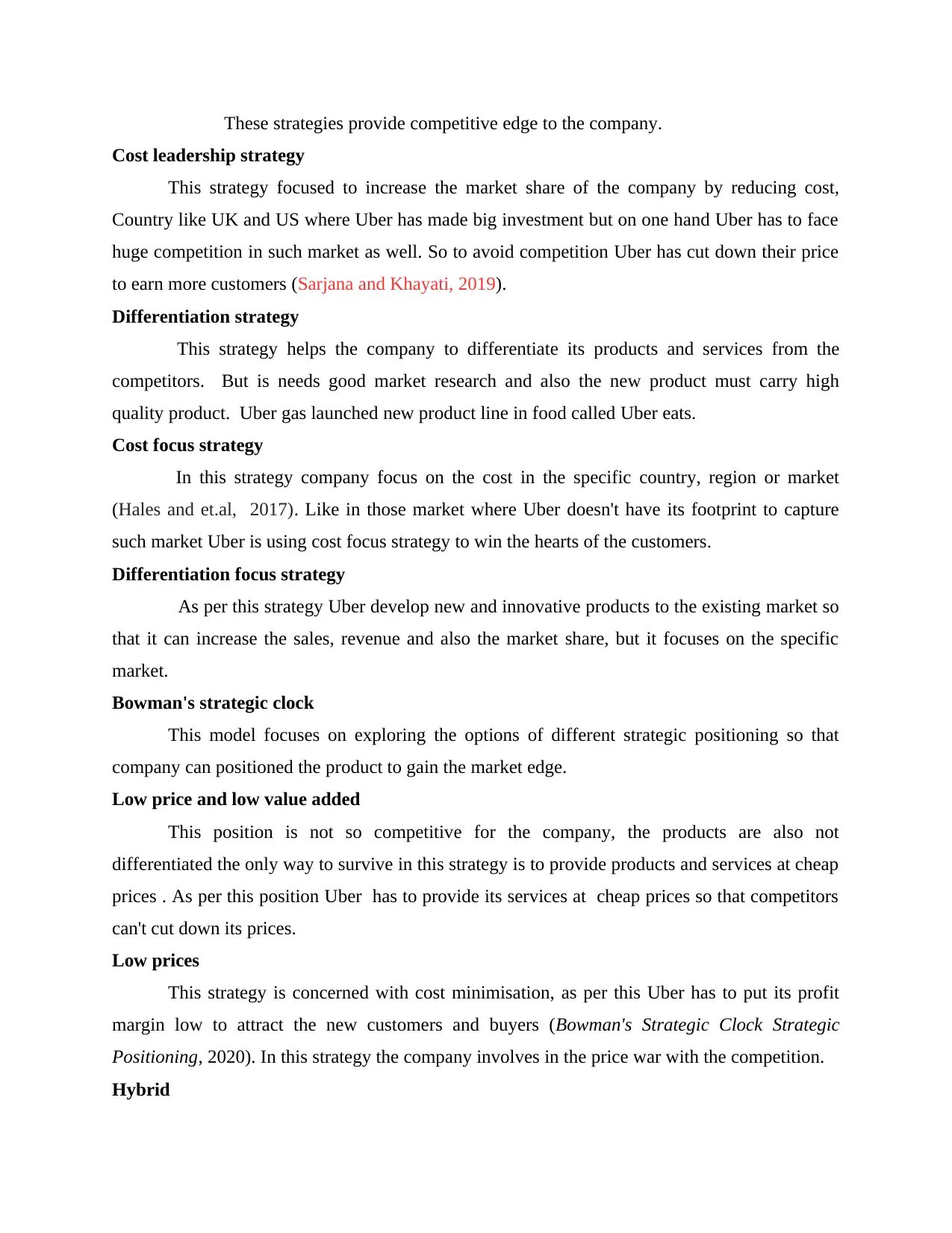
These strategies provide competitive edge to the company.
Cost leadership strategy
This strategy focused to increase the market share of the company by reducing cost,
Country like UK and US where Uber has made big investment but on one hand Uber has to face
huge competition in such market as well. So to avoid competition Uber has cut down their price
to earn more customers (Sarjana and Khayati, 2019).
Differentiation strategy
This strategy helps the company to differentiate its products and services from the
competitors. But is needs good market research and also the new product must carry high
quality product. Uber gas launched new product line in food called Uber eats.
Cost focus strategy
In this strategy company focus on the cost in the specific country, region or market
(Hales and et.al, 2017). Like in those market where Uber doesn't have its footprint to capture
such market Uber is using cost focus strategy to win the hearts of the customers.
Differentiation focus strategy
As per this strategy Uber develop new and innovative products to the existing market so
that it can increase the sales, revenue and also the market share, but it focuses on the specific
market.
Bowman's strategic clock
This model focuses on exploring the options of different strategic positioning so that
company can positioned the product to gain the market edge.
Low price and low value added
This position is not so competitive for the company, the products are also not
differentiated the only way to survive in this strategy is to provide products and services at cheap
prices . As per this position Uber has to provide its services at cheap prices so that competitors
can't cut down its prices.
Low prices
This strategy is concerned with cost minimisation, as per this Uber has to put its profit
margin low to attract the new customers and buyers (Bowman's Strategic Clock Strategic
Positioning, 2020). In this strategy the company involves in the price war with the competition.
Hybrid
Cost leadership strategy
This strategy focused to increase the market share of the company by reducing cost,
Country like UK and US where Uber has made big investment but on one hand Uber has to face
huge competition in such market as well. So to avoid competition Uber has cut down their price
to earn more customers (Sarjana and Khayati, 2019).
Differentiation strategy
This strategy helps the company to differentiate its products and services from the
competitors. But is needs good market research and also the new product must carry high
quality product. Uber gas launched new product line in food called Uber eats.
Cost focus strategy
In this strategy company focus on the cost in the specific country, region or market
(Hales and et.al, 2017). Like in those market where Uber doesn't have its footprint to capture
such market Uber is using cost focus strategy to win the hearts of the customers.
Differentiation focus strategy
As per this strategy Uber develop new and innovative products to the existing market so
that it can increase the sales, revenue and also the market share, but it focuses on the specific
market.
Bowman's strategic clock
This model focuses on exploring the options of different strategic positioning so that
company can positioned the product to gain the market edge.
Low price and low value added
This position is not so competitive for the company, the products are also not
differentiated the only way to survive in this strategy is to provide products and services at cheap
prices . As per this position Uber has to provide its services at cheap prices so that competitors
can't cut down its prices.
Low prices
This strategy is concerned with cost minimisation, as per this Uber has to put its profit
margin low to attract the new customers and buyers (Bowman's Strategic Clock Strategic
Positioning, 2020). In this strategy the company involves in the price war with the competition.
Hybrid
Paraphrase This Document
Need a fresh take? Get an instant paraphrase of this document with our AI Paraphraser
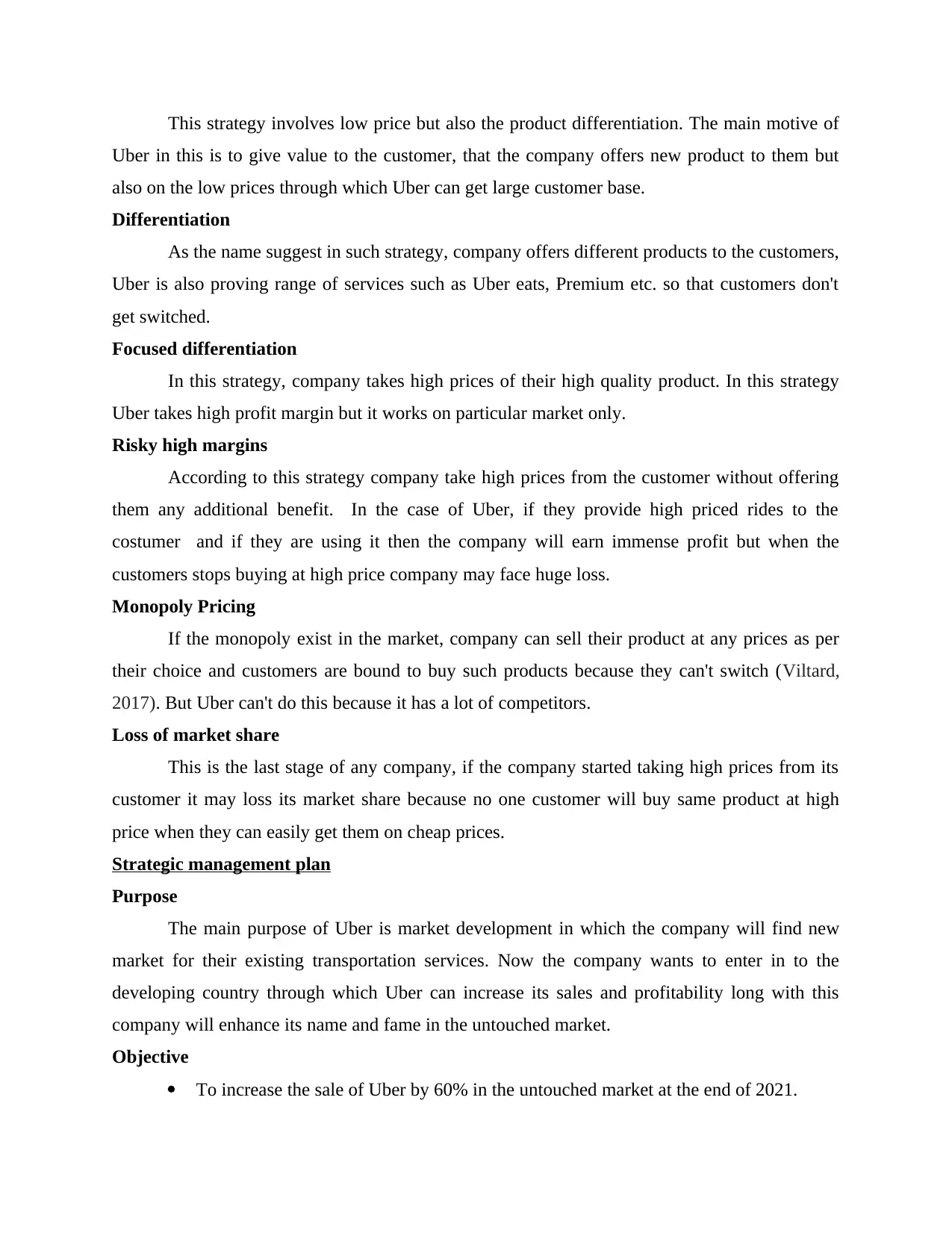
This strategy involves low price but also the product differentiation. The main motive of
Uber in this is to give value to the customer, that the company offers new product to them but
also on the low prices through which Uber can get large customer base.
Differentiation
As the name suggest in such strategy, company offers different products to the customers,
Uber is also proving range of services such as Uber eats, Premium etc. so that customers don't
get switched.
Focused differentiation
In this strategy, company takes high prices of their high quality product. In this strategy
Uber takes high profit margin but it works on particular market only.
Risky high margins
According to this strategy company take high prices from the customer without offering
them any additional benefit. In the case of Uber, if they provide high priced rides to the
costumer and if they are using it then the company will earn immense profit but when the
customers stops buying at high price company may face huge loss.
Monopoly Pricing
If the monopoly exist in the market, company can sell their product at any prices as per
their choice and customers are bound to buy such products because they can't switch (Viltard,
2017). But Uber can't do this because it has a lot of competitors.
Loss of market share
This is the last stage of any company, if the company started taking high prices from its
customer it may loss its market share because no one customer will buy same product at high
price when they can easily get them on cheap prices.
Strategic management plan
Purpose
The main purpose of Uber is market development in which the company will find new
market for their existing transportation services. Now the company wants to enter in to the
developing country through which Uber can increase its sales and profitability long with this
company will enhance its name and fame in the untouched market.
Objective
To increase the sale of Uber by 60% in the untouched market at the end of 2021.
Uber in this is to give value to the customer, that the company offers new product to them but
also on the low prices through which Uber can get large customer base.
Differentiation
As the name suggest in such strategy, company offers different products to the customers,
Uber is also proving range of services such as Uber eats, Premium etc. so that customers don't
get switched.
Focused differentiation
In this strategy, company takes high prices of their high quality product. In this strategy
Uber takes high profit margin but it works on particular market only.
Risky high margins
According to this strategy company take high prices from the customer without offering
them any additional benefit. In the case of Uber, if they provide high priced rides to the
costumer and if they are using it then the company will earn immense profit but when the
customers stops buying at high price company may face huge loss.
Monopoly Pricing
If the monopoly exist in the market, company can sell their product at any prices as per
their choice and customers are bound to buy such products because they can't switch (Viltard,
2017). But Uber can't do this because it has a lot of competitors.
Loss of market share
This is the last stage of any company, if the company started taking high prices from its
customer it may loss its market share because no one customer will buy same product at high
price when they can easily get them on cheap prices.
Strategic management plan
Purpose
The main purpose of Uber is market development in which the company will find new
market for their existing transportation services. Now the company wants to enter in to the
developing country through which Uber can increase its sales and profitability long with this
company will enhance its name and fame in the untouched market.
Objective
To increase the sale of Uber by 60% in the untouched market at the end of 2021.
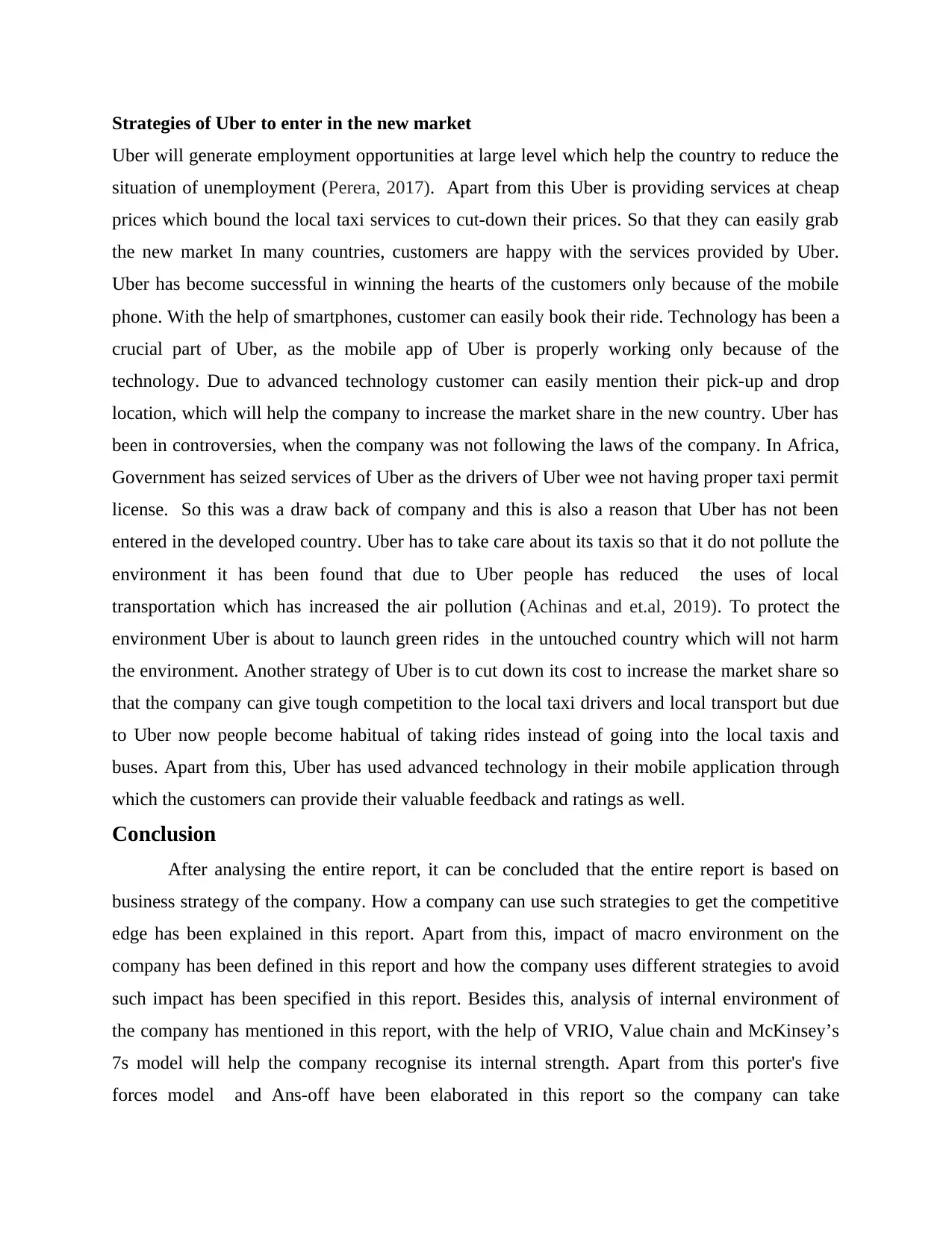
Strategies of Uber to enter in the new market
Uber will generate employment opportunities at large level which help the country to reduce the
situation of unemployment (Perera, 2017). Apart from this Uber is providing services at cheap
prices which bound the local taxi services to cut-down their prices. So that they can easily grab
the new market In many countries, customers are happy with the services provided by Uber.
Uber has become successful in winning the hearts of the customers only because of the mobile
phone. With the help of smartphones, customer can easily book their ride. Technology has been a
crucial part of Uber, as the mobile app of Uber is properly working only because of the
technology. Due to advanced technology customer can easily mention their pick-up and drop
location, which will help the company to increase the market share in the new country. Uber has
been in controversies, when the company was not following the laws of the company. In Africa,
Government has seized services of Uber as the drivers of Uber wee not having proper taxi permit
license. So this was a draw back of company and this is also a reason that Uber has not been
entered in the developed country. Uber has to take care about its taxis so that it do not pollute the
environment it has been found that due to Uber people has reduced the uses of local
transportation which has increased the air pollution (Achinas and et.al, 2019). To protect the
environment Uber is about to launch green rides in the untouched country which will not harm
the environment. Another strategy of Uber is to cut down its cost to increase the market share so
that the company can give tough competition to the local taxi drivers and local transport but due
to Uber now people become habitual of taking rides instead of going into the local taxis and
buses. Apart from this, Uber has used advanced technology in their mobile application through
which the customers can provide their valuable feedback and ratings as well.
Conclusion
After analysing the entire report, it can be concluded that the entire report is based on
business strategy of the company. How a company can use such strategies to get the competitive
edge has been explained in this report. Apart from this, impact of macro environment on the
company has been defined in this report and how the company uses different strategies to avoid
such impact has been specified in this report. Besides this, analysis of internal environment of
the company has mentioned in this report, with the help of VRIO, Value chain and McKinsey’s
7s model will help the company recognise its internal strength. Apart from this porter's five
forces model and Ans-off have been elaborated in this report so the company can take
Uber will generate employment opportunities at large level which help the country to reduce the
situation of unemployment (Perera, 2017). Apart from this Uber is providing services at cheap
prices which bound the local taxi services to cut-down their prices. So that they can easily grab
the new market In many countries, customers are happy with the services provided by Uber.
Uber has become successful in winning the hearts of the customers only because of the mobile
phone. With the help of smartphones, customer can easily book their ride. Technology has been a
crucial part of Uber, as the mobile app of Uber is properly working only because of the
technology. Due to advanced technology customer can easily mention their pick-up and drop
location, which will help the company to increase the market share in the new country. Uber has
been in controversies, when the company was not following the laws of the company. In Africa,
Government has seized services of Uber as the drivers of Uber wee not having proper taxi permit
license. So this was a draw back of company and this is also a reason that Uber has not been
entered in the developed country. Uber has to take care about its taxis so that it do not pollute the
environment it has been found that due to Uber people has reduced the uses of local
transportation which has increased the air pollution (Achinas and et.al, 2019). To protect the
environment Uber is about to launch green rides in the untouched country which will not harm
the environment. Another strategy of Uber is to cut down its cost to increase the market share so
that the company can give tough competition to the local taxi drivers and local transport but due
to Uber now people become habitual of taking rides instead of going into the local taxis and
buses. Apart from this, Uber has used advanced technology in their mobile application through
which the customers can provide their valuable feedback and ratings as well.
Conclusion
After analysing the entire report, it can be concluded that the entire report is based on
business strategy of the company. How a company can use such strategies to get the competitive
edge has been explained in this report. Apart from this, impact of macro environment on the
company has been defined in this report and how the company uses different strategies to avoid
such impact has been specified in this report. Besides this, analysis of internal environment of
the company has mentioned in this report, with the help of VRIO, Value chain and McKinsey’s
7s model will help the company recognise its internal strength. Apart from this porter's five
forces model and Ans-off have been elaborated in this report so the company can take
⊘ This is a preview!⊘
Do you want full access?
Subscribe today to unlock all pages.

Trusted by 1+ million students worldwide
1 out of 14
Related Documents
Your All-in-One AI-Powered Toolkit for Academic Success.
+13062052269
info@desklib.com
Available 24*7 on WhatsApp / Email
![[object Object]](/_next/static/media/star-bottom.7253800d.svg)
Unlock your academic potential
Copyright © 2020–2025 A2Z Services. All Rights Reserved. Developed and managed by ZUCOL.





